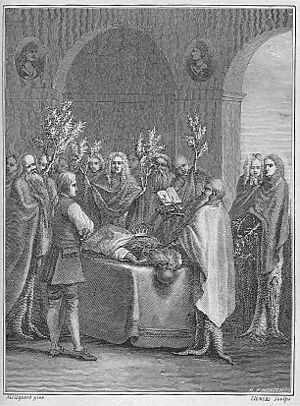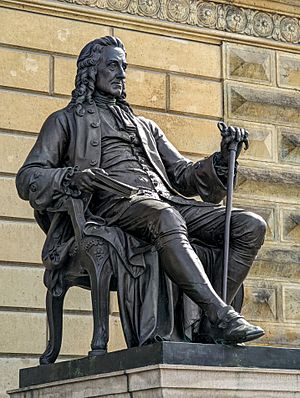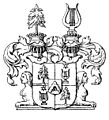Ludvig Holberg facts for kids
Quick facts for kids
Ludvig Holberg
|
|
|---|---|
 |
|
| Born | 3 December 1684 Bergen, Denmark-Norway (now Norway) |
| Died | 28 January 1754 (aged 69) Copenhagen, Denmark-Norway (now Denmark) |
| Occupation |
|
| Nationality | Dano-Norwegian |
| Citizenship | Denmark-Norway |
| Signature | |
Ludvig Holberg (born December 3, 1684 – died January 28, 1754) was a famous writer, thinker, and playwright. He was born in Bergen, Norway, when Norway and Denmark were one country. Holberg is often called the founder of modern Danish and Norwegian literature. He was also well-known across Europe for his writings in Latin.
Holberg was greatly influenced by the Enlightenment. This was a time when people focused on reason and new ideas. He is most famous for the funny plays (comedies) he wrote between 1722 and 1723. These plays were performed at the Lille Grønnegade Theatre in Copenhagen.
Contents
Holberg's Studies and Teaching Career
Ludvig Holberg was the youngest of six brothers. His father, Christian Nielsen Holberg, died when Ludvig was very young. He grew up and studied in Copenhagen.
He first studied theology at the University of Copenhagen. Later, he taught himself about law, history, and languages. He became a teacher at the University of Copenhagen for many years. While teaching, he also started his successful career as a writer. He wrote his first comedies during this time.
Holberg was very well-educated and traveled a lot. When he was young, he visited big cities in the Netherlands and France. He also lived for a short time in Rome and longer in Oxford, England (from 1706 to 1708). Traveling to England was unusual for scholars back then. He spent his time in Oxford using libraries and talking about ideas with English students. These travels gave him many ideas for his later writings.
Holberg's Famous Writings

Holberg's writing career can be divided into three main parts. From 1711 to 1718, he mostly wrote history books. From 1719 to 1731, he focused on funny poems and plays. After 1731, he mainly wrote about philosophy and history.
His comedies, written in the middle period, made him very famous. He was the main playwright for Denmark's first public theater, which opened in Copenhagen in 1721. His plays were very popular right away.
However, a big fire in Copenhagen in 1728 caused hard times. People became more serious, and Holberg's funny plays were less popular. So, he stopped writing comedies and focused on philosophical and historical works.
Holberg wrote only one novel, a satirical science-fiction/fantasy story called Niels Klim's Underground Travels. It was first published in Latin in 1741.
Holberg's Ideas and Beliefs
Holberg was a man of the Age of Enlightenment. He believed strongly in using reason and intellect. He thought that education should teach students to think for themselves, not just memorize books.
He criticized old ways of teaching Christianity. He believed that people should learn to be good humans first, before focusing on religious rules. He said, "Children must be made into men, before they can become Christians."
Holberg was interested in why there was so much evil in the world. He thought that using reason could help solve problems. He moved away from religious explanations for evil and looked for more logical, scientific reasons. This was important because he was a very influential writer.
He also believed that science should be practical and based on observations. For example, in 1745, he wrote about a cattle disease. He suggested that tiny living things (microorganisms) caused the illness. This was a very advanced idea for his time.
Holberg's main goal as a writer was to enlighten people and make society better. He loved big cities with lots of culture. He was not very interested in small towns or nature.
Holberg's Finances and Legacy
When he was young, Holberg did not have much money. He earned a living by teaching and traveling with rich noblemen. He also received a grant to visit universities in other countries. He used this chance to explore places where new ideas were being discussed.
He started writing history books and later wrote about natural and international law. To earn more money, he published his own books. He sold them directly to people who subscribed, either as bound books or loose pages.
Holberg lived a simple life and saved a lot of his money. He often criticized rich people who wasted money on fancy things. He preferred to walk everywhere, saying it helped him stay healthy.
He began investing in real estate, buying farms. One of his properties, Tersløsegard, is still preserved today.
Holberg never married or had children. Towards the end of his life, he had a small fortune. He wanted to leave a lasting mark, so he left his money and properties to Sorø Academy. This was a school for young noblemen. He wanted it to become a university-level institution. The king even gave him the title of Baron of Holberg for his generous gift.
Holberg's tomb, a work by Johannes Wiedewelt, can be seen in Sorø Monastery Church.
Tributes to Ludvig Holberg
Many artists and institutions have honored Ludvig Holberg:
- The Norwegian composer Edvard Grieg wrote the Holberg Suite (opus 40) to celebrate Holberg. This music sounds like country dances from Holberg's time.
- Another Norwegian composer, Johan Halvorsen, wrote music for one of Holberg's plays in 1911. He later turned this music into his Suite Ancienne, dedicating it to Holberg's memory.
- The University of Bergen in Norway gives out the Holberg International Memorial Prize. This is a very important award for people who have done great work in the arts and humanities.
- There is a town named Holberg on Vancouver Island in British Columbia, Canada. Danish immigrants founded it in 1907.
- A statue of Holberg and a street named after him (Holbergsallmenningen) are in the center of Bergen, Norway.
- A crater on the planet Mercury is also named after him.
Holberg's Written Works
Comedies
Holberg wrote many popular comedies, including:
- Den Politiske Kandestøber, 1722 (The Political Tinker)
- Den vægelsindede, 1722 (The Waverer)
- Jean de France eller Hans Frandsen, 1722 (Jean de France)
- Jeppe på bjerget eller den forvandlede Bonde, 1722 (Jeppe of the Hill, or The Transformed Peasant)
- Mester Gert Westphaler, 1722 (Gert Westphaler)
- Barselstuen, 1723 (The Lying-in Room)
- Den ellefte Junii, 1723 (The Eleventh of June)
- Jacob von Tyboe eller den stortalende Soldat, 1723 (Jacob von Tyboe, or The Bragging Soldier)
- Ulysses von Ithacia, 1723 (Ulysses of Ithaca)
- Erasmus Montanus eller Rasmus Berg, 1723 (Erasmus Montanus or Rasmus Berg)
- Don Ranudo de Colibrados, 1723
- Uden Hoved og Hale, 1723 (Without Head or Tail)
- Den Stundesløse, 1723 (The Fidget)
- Hexerie eller Blind Allarm, 1723 (Witchcraft or False Alert)
- Melampe, 1723
- Det lykkelige Skibbrud, 1724 (The Happy Capsize)
- Det Arabiske Pulver, 1724 (The Arabian Powder)
- Mascarade, 1724 (Masquerade)
- Julestuen, 1724 (The Christmas Party)
- De Usynlige, 1724 (The Invisible / The Masked Ladies)
- Diderich Menschenskraek, 1724 (Diderich the Terrible)
- Kildereisen, 1725 (The journey to the source)
- Henrich og Pernille, 1724–1726 (Henrik and Pernille)
- Den pantsatte Bondedreng, 1726 (The Pawned Farmers helper)
- Pernilles korte Frøkenstand, 1727 (Pernille's Brief Experience as a Lady)
- Den Danske Comoedies Liigbegængelse, 1727 (Funeral of Danish Comedy)
- Den honette Ambition, 1731 (The honest ambition)
- Den Forvandlede Brudgom, 1753 (The Changed Bridegroom)
- Plutus eller Proces imellom Fattigdom og Riigdom, publ. 1753
- Husspøgelse eller Abracadabra, publ. 1753 (The house's Ghost or Abracadabra)
- Philosophus udi egen Indbildning, publ. 1754
- Republiqven eller det gemeene Bedste, publ. 1754
- Sganarels Rejse til det philosophiske Land, publ. 1754 (Sganarel's Journey to the Land of the Philosophers)
Poems
- Peder Paars, 1720
- fire Skæmtedigte, 1722 (Four poems for fun)
- Metamorphosis eller Forvandlinger, 1726 (Metamorphosis or Changes)
Novels

- Nicolai Klimii iter subterraneum, 1741. (Translated to Danish in 1742 as Niels Klims underjordiske Rejse.) (English: Niels Klim's Underground Travels)
Essays
- Moralske Tanker, 1744 (Moral thoughts)
- Epistler, 1748–54
- Moralske Fabler, 1751 (Moral Fables)
- Tre latinske levnedsbreve, 1728–1743
Historical works
- Introduction til de fornemste Europæiske Rigers Historier, 1711 (Introduction to the Greatest European Empires Histories)
- Morals Kierne eller Introduction til Naturens og Folke-Rettens Kundskab, 1716 (The Core of Morality or Introduction to Natural and International Law)
- Dannemarks og Norges Beskrivelse, 1729 (Denmark's and Norway's Description)
- Dannemarks Riges Historie, 1732–35 (The Danish Empire's History)
- Den berømmelige Norske Handel-Stad Bergens Beskrivelse, 1737 (The Famous Norwegian Commercial Hub Bergen's Description)
- Almindelig Kirke-Historie, 1738 (General Church History)
- Den jødiske Historie fra Verdens Begyndelse, fortsat til disse Tider, 1742 (The Jewish History From the Beginning of the World, Continued till Present Day)
- Adskillige store Heltes og berømmelige Mænds sammenlignede Historier, 1739–53 (Several Great Heroes' and Famous Men's Compared Histories)
- Adskillige Heltinders og navnkundige Damers sammenlignede Historier, 1745 (Several Heroines' and Noteworthy Ladies' Compared Histories)
Memoir
- Memoirs of Lewis Holberg, 1737 (published in English, 1827)
Images for kids
See also
 In Spanish: Ludvig Holberg para niños
In Spanish: Ludvig Holberg para niños
- Christian Gotlob Mengel




